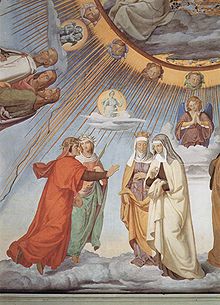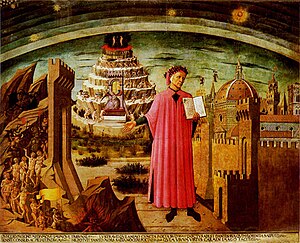
Dante shown holding a copy of the
Divine Comedy, next to the entrance to Hell, the seven terraces of Mount Purgatory and the city of Florence, with the spheres of Heaven above, in
Michelino's fresco
Structure and story[edit]
The
Divine Comedy is composed of 14,233 lines that are divided into three
canticas (Italian plural
cantiche) –
Inferno(
Hell),
Purgatorio (
Purgatory), and
Paradiso (
Paradise) – each consisting of 33
cantos (Italian plural
canti). An initial
canto, serving as an introduction to the poem and generally considered to be part of the first cantica, brings the total number of cantos to 100. It is generally accepted, however, that the first two cantos serve as a unitary prologue to the entire epic, and that the opening two cantos of each cantica serve as prologues to each of the three canticas.
[9][10][11]
The number "three" is prominent in the work, represented in part by the number of canticas and their lengths. Additionally, the verse scheme used,
terza rima, is
hendecasyllabic (lines of eleven syllables), with the lines composing
tercets according to the
rhyme scheme aba, bcb, cdc, ded, ....
Written in the first person, the poem tells of Dante's journey through the three realms of the dead, lasting from
the night before Good Friday to the Wednesday after
Easter in the spring of 1300. The Roman poet
Virgil guides him through Hell and Purgatory;
Beatrice, Dante's ideal woman, guides him through Heaven. Beatrice was a Florentine woman whom he had met in childhood and admired from afar in the mode of the then-fashionable
courtly love tradition, which is highlighted in Dante's earlier work
La Vita Nuova.
[citation needed]
The structure of the three realms follows a common
numerical pattern of 9 plus 1, for a total of 10: 9 circles of the Inferno, followed by Lucifer contained at its bottom; 9 rings of Mount Purgatory, followed by the
Garden of Eden crowning its summit; and the 9 celestial bodies of Paradiso, followed by the
Empyrean containing the very essence of God. Within each group of 9, 7 elements correspond to a specific moral scheme, subdivided into three subcategories, while 2 others of greater particularity are added to total nine. For example, the
seven deadly sins of the Catholic Church that are cleansed in Purgatory are joined by special realms for the Late repentant and the
excommunicated by the church. The core seven sins within Purgatory correspond to a moral scheme of love perverted, subdivided into three groups corresponding to excessive love (
Lust,
Gluttony,
Greed), deficient love (
Sloth), and malicious love (
Wrath,
Envy,
Pride).
[citation needed]
In central Italy's political struggle between
Guelphs and Ghibellines, Dante was part of the Guelphs, who in general favored the
Papacy over the
Holy Roman Emperor. Florence's Guelphs split into factions around 1300: the White Guelphs and the Black Guelphs. Dante was among the White Guelphs who were exiled in 1302 by the Lord-Mayor Cante de'
Gabrielli di
Gubbio, after troops under
Charles of Valois entered the city, at the request of
Pope Boniface VIII, who supported the Black Guelphs. This exile, which lasted the rest of Dante's life, shows its influence in many parts of the
Comedy, from prophecies of Dante's exile to Dante's views of politics, to the eternal damnation of some of his opponents.
[citation needed]
The last word in each of the three canticas is stelle ("stars").
Inferno[edit]

Gustave Doré's engravings illustrated the
Divine Comedy (1861–1868); here
Charon comes to ferry souls across the river
Acheron to Hell.
The poem begins on the
night before Good Friday in the year 1300, "halfway along our life's path" (
Nel mezzo del cammin di nostra vita). Dante is thirty-five years old, half of the biblical lifespan of 70 (
Psalms 89:10, Vulgate), lost in a dark
wood(understood as sin),
[12][13][14] assailed by beasts (a
lion, a
leopard, and a
she-wolf) he cannot evade, and unable to find the "straight way" (
diritta via) – also translatable as "right way" – to salvation (symbolized by the sun behind the mountain). Conscious that he is ruining himself and that he is falling into a "low place" (
basso loco) where the sun is silent ('
l sol tace), Dante is at last rescued by Virgil, and the two of them begin their journey to the underworld. Each sin's punishment in
Infernois a
contrapasso, a symbolic instance of
poetic justice; for example, in Canto XX,
fortune-tellers and
soothsayers must walk with their heads on backwards, unable to see what is ahead, because that was what they had tried to do in life:
they had their faces twisted toward their haunches
and found it necessary to walk backward,
because they could not see ahead of them.
... and since he wanted so to see ahead,
he looks behind and walks a backward path.
[15]
Allegorically, the
Inferno represents the Christian soul seeing sin for what it really is, and the three beasts represent three types of sin: the self-indulgent, the violent, and the malicious.
[16] These three types of sin also provide the three main divisions of Dante's Hell: Upper Hell, outside the city of Dis, for the four sins of indulgence (
lust,
gluttony,
avarice,
anger); Circle 7 for the sins of violence; and Circles 8 and 9 for the sins of malice (fraud and treachery). Added to these are two unlike categories that are specifically spiritual: Limbo, in Circle 1, contains the virtuous pagans who were not sinful but were ignorant of Christ, and Circle 6 contains the heretics who contradicted the doctrine and confused the spirit of Christ. The circles number 9, with the addition of Satan completing the structure of 9 + 1 = 10.
[17]
Purgatorio[edit]
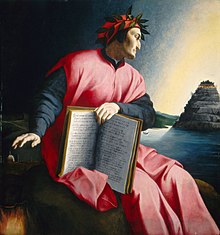
Dante gazes at Mount Purgatory in an allegorical portrait by
Agnolo Bronzino, painted c. 1530
Having survived the depths of Hell, Dante and Virgil ascend out of the undergloom to the Mountain of
Purgatory on the far side of the world. The Mountain is on an island, the only land in the
Southern Hemisphere, created by the displacement of rock which resulted when Satan's fall created Hell
[18] (which Dante portrays as existing underneath
Jerusalem[19]). The mountain has seven terraces, corresponding to the
seven deadly sins or "seven roots of sinfulness."
[20] The classification of sin here is more psychological than that of the
Inferno, being based on motives, rather than actions. It is also drawn primarily from Christian theology, rather than from classical sources.
[21] However, Dante's illustrative examples of sin and virtue draw on classical sources as well as on the Bible and on contemporary events.
Love, a theme throughout the Divine Comedy, is particularly important for the framing of sin on the Mountain of Purgatory. While the love that flows from God is pure, it can become sinful as it flows through humanity. Humans can sin by using love towards improper or malicious ends (
Wrath,
Envy,
Pride), or using it to proper ends but with love that is either not strong enough (
Sloth) or love that is too strong (
Lust,
Gluttony,
Greed). Below the seven purges of the soul is the Ante-Purgatory, containing the Excommunicated from the church and the Late repentant who died, often violently, before receiving rites. Thus the total comes to nine, with the addition of the Garden of Eden at the summit, equaling ten.
[22]
Allegorically, the
Purgatorio represents the Christian life. Christian souls arrive escorted by an angel, singing
In exitu Israel de Aegypto. In his
Letter to Cangrande, Dante explains that this reference to Israel leaving Egypt refers both to the
redemption of
Christ and to "the conversion of the soul from the sorrow and misery of sin to the state of grace."
[23] Appropriately, therefore, it is
Easter Sunday when Dante and Virgil arrive.
The
Purgatorio is notable for demonstrating the medieval knowledge of a
spherical Earth. During the poem, Dante discusses the different stars visible in the
southern hemisphere, the altered position of the sun, and the various
timezones of the Earth. At this stage it is, Dante says, sunset at Jerusalem, midnight on the River
Ganges, and sunrise in Purgatory.
Paradiso[edit]
The first seven spheres of Heaven deal solely with the cardinal virtues of
Prudence,
Fortitude,
Justice and
Temperance. The first three describe a deficiency of one of the cardinal virtues – the
Moon, containing the inconstant, whose vows to God waned as the moon and thus lack fortitude;
Mercury, containing the ambitious, who were virtuous for glory and thus lacked justice; and Venus, containing the lovers, whose love was directed towards another than God and thus lacked Temperance. The final four incidentally are positive examples of the cardinal virtues, all led on by the
Sun, containing the prudent, whose wisdom lighted the way for the other virtues, to which the others are bound (constituting a category on its own).
Mars contains the men of fortitude who died in the cause of Christianity;
Jupiter contains the kings of Justice; and
Saturn contains the temperate, the monks who abided by the contemplative lifestyle. The seven subdivided into three are raised further by two more categories: the eighth sphere of the fixed stars that contain those who achieved the theological virtues of
faith,
hope and
love, and represent the
Church Triumphant – the total perfection of humanity, cleansed of all the sins and carrying all the virtues of heaven; and the ninth circle, or
Primum Mobile (corresponding to the Geocentricism of Medieval astronomy), which contains the angels, creatures never poisoned by original sin. Topping them all is the
Empyrean, which contains the essence of God, completing the 9-fold division to 10.
Dante meets and converses with several great saints of the Church, including
Thomas Aquinas,
Bonaventure,
Saint Peter, and
St. John. The
Paradiso is consequently more theological in nature than the
Inferno and the
Purgatorio. However, Dante admits that the vision of heaven he receives is merely the one his human eyes permit him to see, and thus the vision of heaven found in the Cantos is Dante's personal vision.
The
Divine Comedy finishes with Dante seeing the
Triune God. In a flash of understanding that he cannot express, Dante finally understands the mystery of
Christ's divinity and humanity, and his soul becomes aligned with God's love:
[24]
But already my desire and my will
were being turned like a wheel, all at one speed,
by the Love which moves the sun and the other stars.
[25]
History[edit]
Manuscripts[edit]
According to the Italian Dante Society, no original manuscript written by Dante has survived, although there are many manuscript copies from the 14th and 15th centuries – more than 825 are listed on their site.
[26]
Early printed editions[edit]
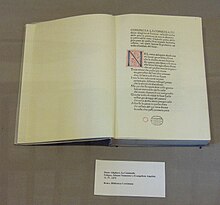
First printed edition, 11 April 1472
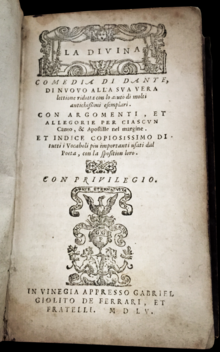
First edition to name the poem
Divina Comedia, 1555

Illustration of
Lucifer in the first fully illustrated print edition. Woodcut for
Inferno, canto 33. Pietro di Piasi, Venice, 1491.
The first printed edition was published in
Foligno, Italy, by Johann Numeister and Evangelista Angelini da
Trevi on
11 April1472.
[27] Of the 300 copies printed, fourteen still survive. The original printing press is on display in the
Oratorio della Nunziatella in Foligno.
Early printed editions
| Date | Title | Place | Publisher | Notes |
|---|
| 1472 | La commedia | Foligno | Johann Numeister and Evangelista Angelini da Trevi | First printed edition |
| 1477 | La commedia | Venice | Wendelin of Speyer | |
| 1481 | Comento di Christophoro Landino fiorentino sopra la Comedia di Dante Alighieri | Florence | Nicolaus Laurentii | With Cristoforo Landino's commentary in Italian, and some engraved illustrations by Baccio Baldini after designs by Sandro Botticelli |
| 1491 | Comento di Christophoro Landino fiorentino sopra la Comedia di Dante Alighieri | Venice | Pietro di Piasi | First fully illustrated edition |
| 1506 | Commedia di Dante insieme con uno diagolo circa el sito forma et misure dello inferno | Florence | Philippo di Giunta | |
| 1555 | La Divina Comedia di Dante | Venice | Gabriel Giolito | First use of "Divine" in title |
Thematic concerns[edit]
The
Divine Comedy can be described simply as an
allegory: each canto, and the episodes therein, can contain many alternative meanings. Dante's allegory, however, is more complex, and, in explaining how to read the poem – see the
Letter to Cangrande[28] – he outlines other levels of meaning besides the allegory: the historical, the moral, the literal, and the
anagogical.
The structure of the poem, likewise, is quite complex, with mathematical and numerological patterns arching throughout the work, particularly threes and nines, which are related to the
Trinity. The poem is often lauded for its particularly human qualities: Dante's skillful delineation of the characters he encounters in Hell, Purgatory, and Paradise; his bitter denunciations of
Florentine and Italian politics; and his powerful poetic imagination. Dante's use of real characters, according to
Dorothy Sayers in her introduction to her translation of the
Inferno, allows Dante the freedom of not having to involve the reader in description, and allows him to "[make] room in his poem for the discussion of a great many subjects of the utmost importance, thus widening its range and increasing its variety."
[29]
Dante called the poem "Comedy" (the adjective "Divine" was added later in the 16th century) because poems in the ancient world were classified as High ("Tragedy") or Low ("Comedy").
[30] Low poems had happy endings and were written in everyday language, whereas High poems treated more serious matters and were written in an elevated style. Dante was one of the first in the Middle Ages to write of a serious subject, the Redemption of humanity, in the low and "vulgar" Italian language and not the Latin one might expect for such a serious topic.
Boccaccio's account that an early version of the poem was begun by Dante in
Latin is still controversial.
[31][32]
Scientific themes[edit]

Albert Ritter sketched the Comedy's geography from Dante's Cantos: Hell's entrance is near Florence with the circles descending to Earth's centre; sketch 5 reflects Canto 34's inversion as Dante passes down, and thereby up to Mount Purgatory's shores in the southern hemisphere, where he passes to the first sphere of Heaven at the top.
Although the
Divine Comedy is primarily a religious poem, discussing sin, virtue, and theology, Dante also discusses several elements of the
science of his day (this mixture of science with poetry has received both praise and blame over the centuries
[33]). The
Purgatorio repeatedly refers to the implications of a
spherical Earth, such as the different stars visible in the
southern hemisphere, the altered position of the
sun, and the various
timezones of the Earth. For example, at sunset in Purgatory it is midnight at the
Ebro, dawn in Jerusalem, and noon on the River Ganges:
[34]
Just as, there where its Maker shed His blood,
the sun shed its first rays, and Ebro lay
beneath high Libra, and the ninth hour's rays
were scorching Ganges' waves; so here, the sun
stood at the point of day's departure when
God's angel—happy—showed himself to us.
[35]
Dante travels through the centre of the Earth in the
Inferno, and comments on the resulting change in the direction of
gravity in Canto XXXIV (lines 76–120). A little earlier (XXXIII, 102–105), he queries the existence of wind in the frozen inner circle of hell, since it has no temperature differentials.
[36]
Inevitably, given its setting, the
Paradiso discusses
astronomy extensively, but in the
Ptolemaic sense. The
Paradiso also discusses the importance of the
experimental method in science, with a detailed example in lines 94–105 of Canto II:
Yet an experiment, were you to try it,
could free you from your cavil and the source
of your arts' course springs from experiment.
Taking three mirrors, place a pair of them
at equal distance from you; set the third
midway between those two, but farther back.
Then, turning toward them, at your back have placed
a light that kindles those three mirrors and
returns to you, reflected by them all.
Although the image in the farthest glass
will be of lesser size, there you will see
that it must match the brightness of the rest.
[37]
Galileo Galilei is known to have lectured on the
Inferno, and it has been suggested that the poem may have influenced some of Galileo's own ideas regarding mechanics.
[38]
Theories of influence from Islamic philosophy[edit]
Some "superficial similarities"
[41] of the
Divine Comedy to the
Resalat Al-Ghufran or
Epistle of Forgiveness of
Al-Ma'arri have also been mentioned in this debate. The
Resalat Al-Ghufran describes the journey of the poet in the realms of the afterlife and includes dialogue with people in Heaven and Hell, although, unlike the
Kitab al Miraj, there is little description of these locations,
[42] and it is unlikely that Dante borrowed from this work.
[43][44]
Dante did, however, live in a Europe of substantial literary and philosophical contact with the Muslim world, encouraged by such factors as
Averroism ("Averrois, che'l gran comento feo" Commedia, Inferno, IV, 144, meaning "Averrois, who wrote the great comment") and the patronage of
Alfonso X of Castile. Of the twelve wise men Dante meets in Canto X of the
Paradiso,
Thomas Aquinas and, even more so,
Siger of Brabant were strongly influenced by Arabic commentators on
Aristotle.
[45]Medieval
Christian mysticism also shared the
Neoplatonic influence of
Sufis such as
Ibn Arabi. Philosopher
Frederick Copleston argued in 1950 that Dante's respectful treatment of
Averroes,
Avicenna, and Siger of Brabant indicates his acknowledgement of a "considerable debt" to Islamic philosophy.
[45]
Although this philosophical influence is generally acknowledged, many scholars have not been satisfied that Dante was influenced by the
Kitab al Miraj. The 20th century Orientalist
Francesco Gabrieli expressed skepticism regarding the claimed similarities, and the lack of evidence of a vehicle through which it could have been transmitted to Dante. Even so, while dismissing the probability of some influences posited in Palacios' work,
[46] Gabrieli conceded that it was "at least possible, if not probable, that Dante may have known the
Liber scalae and have taken from it certain images and concepts of Muslim eschatology". Shortly before her death, the Italian philologist
Maria Corti pointed out that, during his stay at the court of Alfonso X, Dante's mentor
Brunetto Latini met Bonaventura de Siena, a Tuscan who had translated the
Kitab al Miraj from Arabic into Latin. Corti speculates that Brunetto may have provided a copy of that work to Dante.
[47] René Guénon, a Sufi convert and scholar of Ibn Arabi, rejected in
The Esoterism of Dante the theory of his influence (direct or indirect) on Dante.
[48]
Literary influence in the English-speaking world and beyond[edit]
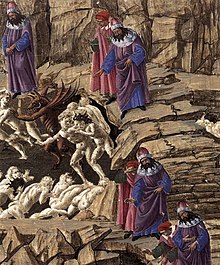
A detail from one of
Sandro Botticelli's illustrations for
Inferno, Canto XVIII, 1480s. Silverpoint on parchment, completed in pen and ink.
The
Divine Comedy was not always as well-regarded as it is today. Although recognized as a
masterpiece in the centuries immediately following its publication,
[49] the work was largely ignored during the
Enlightenment, with some notable exceptions such as
Vittorio Alfieri;
Antoine de Rivarol, who translated the
Inferno into French; and
Giambattista Vico, who in the
Scienza nuova and in the
Giudizio su Dante inaugurated what would later become the romantic reappraisal of Dante, juxtaposing him to Homer.
[50] The
Comedy was "rediscovered" in the English-speaking world by
William Blake – who illustrated several passages of the epic – and the
romantic writers of the 19th century. Later authors such as
T. S. Eliot,
Ezra Pound,
Samuel Beckett,
C. S. Lewis and
James Joyce have drawn on it for inspiration. The poet
Henry Wadsworth Longfellow was its first American translator,
[51] and modern poets, including
Seamus Heaney,
[52] Robert Pinsky,
John Ciardi,
W. S. Merwin, and
Stanley Lombardo, have also produced translations of all or parts of the book. In Russia, beyond
Pushkin's translation of a few tercets,
[53] Osip Mandelstam's late poetry has been said to bear the mark of a "tormented meditation" on the
Comedy.
[54]In 1934, Mandelstam gave a modern reading of the poem in his labyrinthine "Conversation on Dante".
[55] In T. S. Eliot's estimation, "Dante and Shakespeare divide the world between them. There is no third."
[56] For
Jorge Luis Borges the
Divine Comedy was "the best book literature has achieved".
[57]
English translations[edit]
New English translations of the
Divine Comedy continue to be published regularly. Notable English translations of the complete poem include the following.
[58]
A number of other translators, such as
Robert Pinsky, have translated the
Inferno only.
In the arts[edit]
The
Divine Comedy has been a source of inspiration for countless artists for almost seven centuries. There are many references to Dante's work in
literature. In
music,
Franz Liszt was one of many composers to write
works based on the
Divine Comedy. In
sculpture, the work of
Auguste Rodin includes themes from Dante, and many
visual artists have illustrated Dante's work, as shown by the examples above. There have also been many references to the
Divine Comedy in
cinema and
computer games.
Gallery[edit]
Series of woodcuts illustrating Dante's Hell by Antonio Manetti (1423–1497):
From Dialogo di Antonio Manetti, cittadino fiorentino, circa al sito, forma, et misure dello inferno di Dante Alighieri poeta excellentissimo (Florence: F. Giunta, 1510?) |
|---|
|
|
"Everything Reduced to One Plan", 1506
|
|
|
"The Chamber of Hell", 1506
|
|
|
"Circles Six and Seven", 1506
|
|
|
"The Lair of Geryon", 1506
|
|
|
"The Tomb of Lucifer", 1506
|
|
| La materia della Divina commedia di Dante Alighieri, dichiarata in VI tavole, by Michelangelo Caetani (1804–1882) |
|---|
|
|
Plate I: "Overview of the Divine Comedy"
|
|
|
Plate IV: "Cross Section of Hell"
|
|
|
Plate V: "The Ordering of Purgatory"
|
|
|
Plate VI: "The Ordering of Paradise"
|
|








